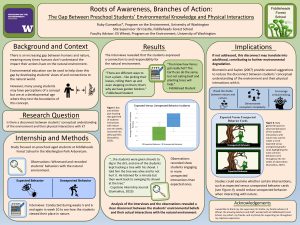Roots of Awareness, Branches of Action: Environmental Knowledge-Action Gaps In Preschool-Aged Students
Reduced access to nature results in more individuals losing their connection to it, which makes it difficult for people to see how their actions harm the natural environment. Nature is necessary for human survival, providing sustenance and improving well-being. Environmental education (EE) can help students connect with nature and better understand the environmental effects of their actions. However, going into my internship I believed there might be a gap between students’ interactions and their perceptions of nature. My research investigates the question: What disconnects exist between students’ conceptual understanding of the natural environment and their physical interactions with it? I interned at Fiddleheads Forest School with preschool-aged children. Here, I collected data three days a week in two different classrooms by observing the students’ interactions with nature. I also conducted two rounds of interviews throughout the quarter to analyze the students’ perceptions of and connections to nature. Results from my interviews and observations reveal a disconnect between young students’ perceptions of nature and their actual interactions with it. While the interviews demonstrate the students’ expression of deep care for and connection to the natural environment, my observations revealed that the students engage in more unexpected than expected interactions with nature. These results are important because, if not addressed, a disconnect at a young age could translate into a disconnect as an adult. So, in thinking about the future, EE should focus not only on teaching concepts about nature but also promoting positive interactions with it!
